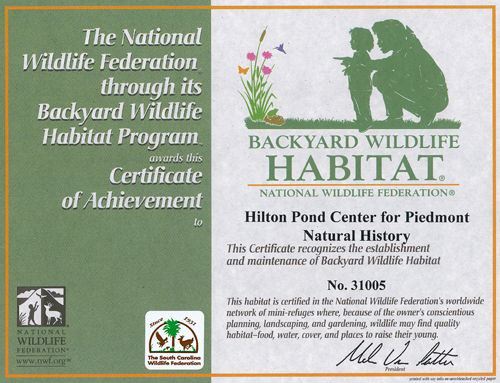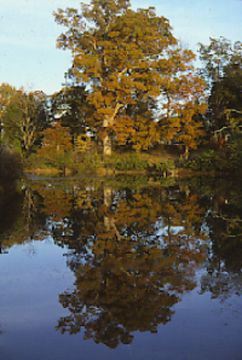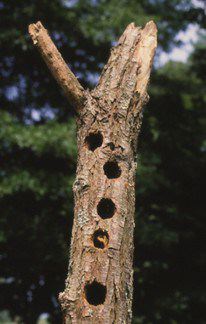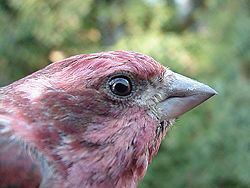ON BECOMING A CERTIFIED
BACKYARD WILDLIFE HABITAT
It may belabor the obvious to say Hilton Pond Center is a "wildlife habitat." Even a cursory look at the Center's Web site reveals this 11-acre tract in the South Carolina Piedmont is home to a wide variety of fauna, from beetles to bullfrogs and copperheads to cotton rats. It has been our goal since acquiring the property in 1982 to create-- intentionally or through benign neglect--a tract as amenable to wildlife as possible. We've been reasonably successful, and now we're pleased to announce that Hilton Pond Center is officially recognized as a "Certified Backyard Wildlife Habitat," according to the standards of the National Wildlife Federation (NWF).

All photos & text © Hilton Pond Center
To be honest, the Center could have qualified for this designation long ago, but we never got around to filling out the application form or submitting the modest $15 processing fee. We finally overcame inertia late last fall and sent to NWF a rationale for why the Center should be awarded official certification. As part of the application process, we compiled information about the following habitat components at Hilton Pond Center:
- Plant List--trees, shrubs, grasses, perennials, annuals, ferns, cacti, etc.
- Natural Food--plant foods such as seeds, nuts, berries, fruits nectar, foliage/twigs, sap, and pollen (Flowering Dogwood berry, below right)

- Feeders--tube, platform, suet, hummingbird, etc.
- Water--birdbath, water garden/pond, lakefront, riverfront, stream, wetland, vernal pool, puddling area (for adult butterflies), coastal, spring/seep, etc.
- Cover--wooded area, dense shrubs/thicket, bramble patch, evergreens, ground cover, brush pile, log pile, rock pile/wall, meadow/scrub/prairie, etc.
- Places to Raise Young--mature trees, dense shrubs/thicket, meadow/scrub/prairie, water garden/wetland, trees with cavities, dens in the ground, plants for caterpillars to eat, etc.
- Resource Conservation--establishing a rain garden or buffer to filter storm water, capturing roof rain water, mulching, planting native plants suitable to the area, reducing or eliminating pesticide and chemical fertilizer use, reducing or eliminating lawn areas, keeping your cat indoors
- Local Wildlife--insects/invertebrates, fish, amphibians, reptiles, birds, mammals
Along with the completed application form, NWF also requested photos or sketches of several habitats at Hilton Pond Center, and we were able to refer them to a wide selection of images on the Center's Web site.
 NWF says that in the years since its program began in 1973, "Backyard Wildlife Habitats have sprouted in urban, suburban, and rural sites . . . from post offices, schools, and places of worship, to hospitals, community parks, and municipal facilities. The majority can be found at residential properties . . . ." Some of these sites are tiny inner-city yards or enclosed courtyards at nursing homes, while others may be hundred-acre nature reserves. The point is that virtually ANY piece of property can be a wildlife habitat, and the world would be a much better place if EVERY landowner made an attempt to make that property compatible with wildlife in some small way. Every little bit DOES help, so you don't have to be landed gentry or hold a degree in conservation biology to qualify for Backyard Wildlife Habitat recognition from the National Wildlife Federation. NWF says that in the years since its program began in 1973, "Backyard Wildlife Habitats have sprouted in urban, suburban, and rural sites . . . from post offices, schools, and places of worship, to hospitals, community parks, and municipal facilities. The majority can be found at residential properties . . . ." Some of these sites are tiny inner-city yards or enclosed courtyards at nursing homes, while others may be hundred-acre nature reserves. The point is that virtually ANY piece of property can be a wildlife habitat, and the world would be a much better place if EVERY landowner made an attempt to make that property compatible with wildlife in some small way. Every little bit DOES help, so you don't have to be landed gentry or hold a degree in conservation biology to qualify for Backyard Wildlife Habitat recognition from the National Wildlife Federation.
Hilton Pond Center (above left) may have been a little slow in applying to NWF for its official certification as a Backyard Wildlife Habitat, but we're still proud to become the 31,005th property so designated.  And we're taking this space to brag on our certificate in the hope it will stimulate you to do what you can to make your yard certifiable AND that you'll take the time to send your own application to the National Wildlife Federation. (If you're really industrious, you might even consider establishing a Community Wildlife Habitat that involves at least 20% of its single-family homes, 10% of the apartment buildings, a Schoolyard Habitat, and a demonstration habitat at a workplace or other public site.) And we're taking this space to brag on our certificate in the hope it will stimulate you to do what you can to make your yard certifiable AND that you'll take the time to send your own application to the National Wildlife Federation. (If you're really industrious, you might even consider establishing a Community Wildlife Habitat that involves at least 20% of its single-family homes, 10% of the apartment buildings, a Schoolyard Habitat, and a demonstration habitat at a workplace or other public site.)
So quit maintaining your sterile, manicured lawn; plant some native fruit-bearing shrubs; don't cut that snag (right) that could provide a woodpecker home; put in a water garden; keep your house cat indoors; visit the National Wildlife Federation's Web site for details on the Backyard Wildlife Habitat Program; and support your NWF State Affiliate in its efforts to help protect flora and fauna in your own backyard.
Do any or all of this and we're willing to bet the local wildlife will appreciate--or at least benefit from--each of your thoughtful actions.
All photos & text © Hilton Pond Center
If you enjoy "This Week at Hilton Pond," please help Support
Hilton Pond Center for Piedmont Natural History.
It's painless, and YOU can make a difference!
You may wish to consult our Index of all nature topics covered since February 2000.
|



 NWF says that in the years since its program began in 1973, "Backyard Wildlife Habitats have sprouted in urban, suburban, and rural sites . . . from post offices, schools, and places of worship, to hospitals, community parks, and municipal facilities. The majority can be found at residential properties . . . ." Some of these sites are tiny inner-city yards or enclosed courtyards at nursing homes, while others may be hundred-acre nature reserves. The point is that virtually ANY piece of property can be a wildlife habitat, and the world would be a much better place if EVERY landowner made an attempt to make that property compatible with wildlife in some small way. Every little bit DOES help, so you don't have to be landed gentry or hold a degree in conservation biology to qualify for Backyard Wildlife Habitat recognition from the National Wildlife Federation.
NWF says that in the years since its program began in 1973, "Backyard Wildlife Habitats have sprouted in urban, suburban, and rural sites . . . from post offices, schools, and places of worship, to hospitals, community parks, and municipal facilities. The majority can be found at residential properties . . . ." Some of these sites are tiny inner-city yards or enclosed courtyards at nursing homes, while others may be hundred-acre nature reserves. The point is that virtually ANY piece of property can be a wildlife habitat, and the world would be a much better place if EVERY landowner made an attempt to make that property compatible with wildlife in some small way. Every little bit DOES help, so you don't have to be landed gentry or hold a degree in conservation biology to qualify for Backyard Wildlife Habitat recognition from the National Wildlife Federation. And we're taking this space to brag on our certificate in the hope it will stimulate you to do what you can to make your yard certifiable AND that you'll take the time to send your own application to the National Wildlife Federation. (If you're really industrious, you might even consider establishing a Community Wildlife Habitat that involves at least 20% of its single-family homes, 10% of the apartment buildings, a Schoolyard Habitat, and a demonstration habitat at a workplace or other public site.)
And we're taking this space to brag on our certificate in the hope it will stimulate you to do what you can to make your yard certifiable AND that you'll take the time to send your own application to the National Wildlife Federation. (If you're really industrious, you might even consider establishing a Community Wildlife Habitat that involves at least 20% of its single-family homes, 10% of the apartment buildings, a Schoolyard Habitat, and a demonstration habitat at a workplace or other public site.)

